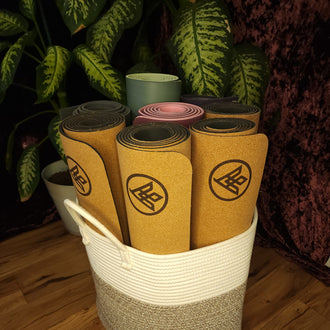Kona (Angle)
Jack UtermoehlShare
Kona is a Sanskrit word meaning “angle” or “corner.”
In yoga, it is most often seen in posture names where the shape of the body creates a strong angular relationship between limbs, such as in standing or lateral extension poses.
Kona shapes help direct energy, define alignment, and awaken spaciousness in the body. They often involve side bends, extensions, or the creation of triangles and diagonals that organize the body into clear lines of energy.
Etymology and Meaning
Sanskrit Spelling: कोण
Root Word: "Kona" (angle, bend, corner)
Translation Variations: Angle, point, intersection, geometric form
Pronunciation: Kona [KOH-nah]
Kona suggests both structure and directional flow, inviting the practitioner to explore energy pathways and refine the geometry of their posture.
Common Kona Postures
- Trikonasana: Triangle Pose is one of the most iconic angle-based postures
- Parivrtta Trikonasana: Revolved Triangle Pose
- Utthita Parsvakonasana: Extended Side Angle Pose
- Parivrtta Parsvakonasana: Revolved Side Angle Pose
These poses use strong angular relationships between the legs, spine, and arms to create stability, extension, and rotation.
Symbolism and Energy
Element: Fire or air - kona postures tend to energize, expand, and clarify
Chakra Focus: Manipura (solar plexus) for power and balance, Anahata (heart) for space and openness
Energetic Function: Directing prana (life force energy) through clean geometric pathways, improving stability and alignment

Explore Our Full Collection
Discover all the yoga essentials and accessories you need to enhance your practice. Shop now and elevate your yoga practice.
Shop NowPractical Application
In Yoga Practice
- Use kona-based poses to build both strength and mobility, particularly in the legs and torso
- Refine your angles by rooting through the feet and extending through the crown or fingertips
- Balance the activation of both sides of the body to maintain energetic symmetry
In Daily Life
- Notice the angles of your posture in daily habits like sitting, walking, or carrying weight
- Play with changing perspective, kona reminds us that one shift in angle can change our whole view
- Let your body explore diagonals and side bends to counterbalance forward-leaning patterns
Quotes and Wisdom
"Geometry is the language of alignment. Kona is where structure meets energy."
"Every triangle teaches us stability, but also how to open through precision."
Modern Relevance
In modern yoga practice, kona postures are foundational for exploring the body's lines, boundaries, and potential for expansion.
Whether you're working on strength, mobility, or flexibility, kona shapes offer a framework to explore integration.
They train attention to detail, spatial awareness, and presence within the physical form.
Related Concepts
Utthita (Extended): Often seen in angle-based postures
Parivrtta (Revolved): Adds rotation to angular shapes
Asana (Physical Postures): Kona gives structure within asana form
How to Work with Kona
Mindset: Let geometry reveal clarity, structure can be a gateway to flow
Actions: Explore triangle and side angle poses with focus on grounding and elongation
Reflection: Ask, “Where in my practice can sharper alignment create deeper freedom?”
Suggested Reading
- Light on Yoga by B.K.S. Iyengar
- The Key Muscles of Yoga by Ray Long
- The Heart of Yoga by T.K.V. Desikachar
Conclusion
Kona shapes are where structure, energy, and intention meet.
They offer a clear, geometric container for exploring inner and outer balance.
Every angle created on the mat reflects the angles we hold in life and through awareness, we can refine both.






